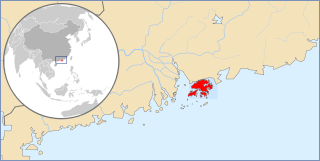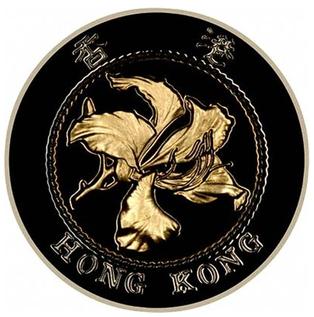Related Research Articles

The issue of banknotes of the Hong Kong dollar is governed in the Special Administrative Region of Hong Kong by the Hong Kong Monetary Authority (HKMA), the governmental currency board of Hong Kong. Under licence from the HKMA, three commercial banks issue their own banknotes for general circulation in the region. Notes are also issued by the HKMA itself.
The Mercantile Bank of India, London and China, later Mercantile Bank Ltd, was an Anglo-Indian bank with business focus in the Far East. It was founded in Bombay in 1853 as the Mercantile Bank of Bombay; and later in 1857 was renamed to Mercantile Bank of India, London, and China with London as its headquarters.
The one-dollar coin is the fourth-highest and fourth-lowest denomination coin of the Hong Kong dollar.

The one-cent banknote was the smallest denominated banknote issued in Hong Kong. They were issued by the government and were initially released on 30 May 1941 and printed by Noronha and Company Limited to provide small change because of a lack of coinage brought on by the second world war. The first issue was 42 by 75 mm, the obverse was brown with a serial number of seven numbers with either no prefix or an A or B prefix. This side was mostly in English, except for "Government of Hong Kong" which was also in Chinese. The reverse was red and the denomination in English and Chinese. After the Japanese take over of Hong Kong the issue was replaced by the Japanese Military Yen.

The Oriental Bank Corporation, or "OBC", was a British imperial bank founded in India in 1842 which grew to be prominent throughout the Far East. As an Exchange bank, the OBC was primarily concerned with the finance of trade and exchanges of different currencies. It was the first bank in Hong Kong and the first bank to issue banknotes in Hong Kong.

The ten-dollar coin is the highest-valued circulating coin issued in Hong Kong.
The five dollar coin is the second-highest denomination coin of the Hong Kong dollar. It replaced the five dollar banknotes in 1976.

The two dollar coin is the third-highest denomination coin of the Hong Kong dollar. Since its introduction in 1976, it is one of two circulating coins to not be round. The two dollar coin is a dodecagonal scallop in shape, and made of cupro-nickel.
The ten-dollar note was first produced in 1868 by The Hongkong and Shanghai Banking Corporation with the formal adoption of a currency system just for Hong Kong. There had been a variety of the green coloured ten-dollar notes issued by several banks concurrently. These were all phased out with the introduction of the ten dollar coin in 1994.

The one mil coin was the smallest denomination of the Hong Kong dollar from 1863 to 1866, after this date it was no longer issued but may have circulated much longer. Its value was one tenth of a cent, or a thousandth of a dollar. It was minted by the Royal Mint, it features the Royal cypher of "VR", of the reigning monarch Queen Victoria at the time, but didn't feature a profile of the face of the monarch as all other coins did, due to the hole in the middle.

The one-cent coin was the smallest-denomination coin of the Hong Kong dollar since 1866 until its replacement in 1941 by the one-cent note. During World War II the loss of coins dated 1941 along with their subsequent melting during the Japanese occupation of Hong Kong has resulted in the survival of no more than 100 coins.
The twenty-dollar note was first issued by the Oriental Bank Corporation from 1866 to 1884. These banknotes are not very common and are listed as extremely rare. Apart from this, the banknote was reintroduced in 1985 by the Standard Chartered Bank in green and yellow, followed by The Hongkong and Shanghai Banking Corporation in 1986 in similar colours, but more green involved. The Bank of China issued their version in 1994 as a blue coloured banknote. These were standardised in 2004 when all three types of banknotes were changed to a blue colour.
The fifty-dollar note was first issued undated in the 1860s by the Oriental Bank Corporation, the Mercantile Bank, the Standard Chartered Bank but a confirmed date for this bank is 1879, followed by The Hongkong and Shanghai Banking Corporation in 1877. The National Bank of China also issued this denomination in the 1890s, but they are seldom seen. There was a continuous issue till the Second World War in different colours and dimensions, but they ceased to be printed between 1934 and 1941, depending on the bank. After the war no banks resumed to issue this denomination. They were resumed by The Hongkong and Shanghai Banking Corporation in 1968 the Standard Chartered Bank in 1970 as a blue note. This was then changed to purple in 1985 with a new smaller version and then to the current green issue in 2003. The Bank of China issued their version in 1994. The colour was made uniform when green for all banknotes was adopted.
The Hong Kong one hundred dollar note was first issued from 1858 from the Mercantile Bank, 1866 by the Oriental Bank Corporation, the Standard Chartered Bank from the 1860s but a confirmed date for this bank is 1879, followed by The Hongkong and Shanghai Banking Corporation in 1877. Specimens are known from the Agra and Masterman's Bank and the Asiatic Banking Corporation that existed between 1862–66 and from The National Bank of China in the 1890s. There was a continuous issue till the Second World War in different colours and dimensions, and this issue was resumed after the war in 1946, by the HSBC, Mercantile and Standard Chartered Banks. This was somewhat standardised in 1970 when the Chartered Bank changed the issue from brown to red, red was the colour of the other two issues. The Mercantile bank stopped issuing banknotes after 1974 and the Bank of China issued their version in 1994. The colour was made uniform when red for all banknotes was adopted.
The Hong Kong five hundred dollar note was first issued in undated from the 1860s by the Oriental Bank Corporation, the Standard Chartered Bank but a confirmed date for this bank is 1879, followed by The Hongkong and Shanghai Banking Corporation in 1877, the Mercantile Bank in 1948 and the Bank of China in 1994. The Specimens are known from the Agra and Masterman's Bank and the Asiatic Banking Corporation between 1862-66. The National Bank of China issued theirs in the 1890s. There was a continuous issue till the Second World War in different colours and dimensions, they were reissued from 1946. The Mercantile bank ceased issue of this denomination after 1959. There was a standardisation of size in 1979 when the Chartered Bank reduced the size to that similar to HSBC. The colour was made uniform in 2003 when brown for all banknotes was adopted.
The one thousand-dollar note is the highest-valued banknote in circulation in Hong Kong. Currently, this note is issued by the Hongkong and Shanghai Banking Corporation (HSBC), Standard Chartered Hong Kong, and the Bank of China. Due to its gold-colored theme, this note was nicknamed “Gold Cow ” by the locals, derived from the term “Big Cow ” that is used for the city's five hundred-dollar note. If counted according to the notes’ serial number, it is the note with the second-lowest printing figure, higher than that of the fifty-dollar note.
The Hong Kong five-cent note was issued by the government, initially released on 16 October 1941 and printed by Noronha and Company Limited to provide small change because of a lack of coinage brought on by the Second World War. The first issue was 48 by 85 mm; the obverse was green with serial numbers of seven numbers with no prefix. This side was mostly in English, except for "Government of Hong Kong" which was also in Chinese. The reverse was blue and the denomination in English and Chinese. After the Japanese take-over of Hong Kong, the issue was replaced by the Japanese military yen.
The ten cent banknote was a banknote issued in Hong Kong. They were issued by the government, and were initially released on 16 October 1941 and printed by Noronha and Company Limited, to provide small change because of a lack of coinage brought on by the Second World War, and an influx of people because of the Second Sino-Japanese War. The first issue was 55 by 95 mm, and the obverse was red with a serial number of seven numbers, with no prefix. This side was mostly in English, except for "Government of Hong Kong" which was also in Chinese. The reverse was blue and had the denomination in English and Chinese. After the Japanese take over of Hong Kong, the issue was replaced by the Japanese Military Yen.

The one dollar note was first issued by The Hongkong and Shanghai Banking Corporation from 1872 to 1935. No other bank issued this denomination. In 1935 the Government of Hong Kong took over the issuing and became the sole issuer for this denomination. There was a continuous issue till the Second World War when it was replaced by the Japanese Military Yen, and this issue was resumed after the war in 1946, until 1960, when it was replaced with a coin. The initial issue by the HSBC was brown on the obverse and red on the reverse. The note was stylised and was 189 by 123 mm. This was changed in 1889 to a new design and size, now it was 129 by 86 and the colours were blue on the obverse and red on the reverse. This lasted till 1904 when a new issue was released, being 132 by 90 mm and green on the obverse and orange the reverse. The colour and size of this issue was changed in 1923 to 131 by 93 mm and was green on both sides. The last issue by the HSBC was in 1926 when a new design 131 by 95 was issued in blue obverse and purple reverse, both sides with a yellow background.
The five-dollar note was first issued in 1858 by the Mercantile Bank, 1865 by the Standard Chartered Bank, 1866 by the Oriental Bank Corporation, 1897 by The Hongkong and Shanghai Banking Corporation, and 1894 by the National Bank of China. There was a continuous issue until the Second World War in different colours and dimensions, and this issue was resumed after the war in 1946, by the HSBC and Standard Chartered banks. The various banks' designs were somewhat standardised in 1970 when the Chartered Bank changed the issue from green to brown, as this was the colour of the HSBC issue. The Standard Charted Bank issued two colours from 1967 to 1970, a yellow and green note. These are described as being a yellow and green key in reference to the image of two keys on either side of the banknote. This denomination was replaced by a coin in 1976.
References
- Ma Tak Wo 2004, Illustrated Catalogue of Hong Kong Currency, Ma Tak Wo Numismatic Co., LTD Kowloon Hong Kong. ISBN 962-85939-3-5

